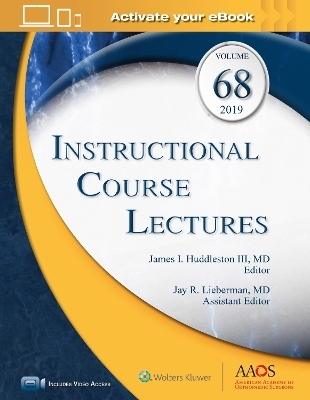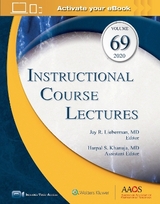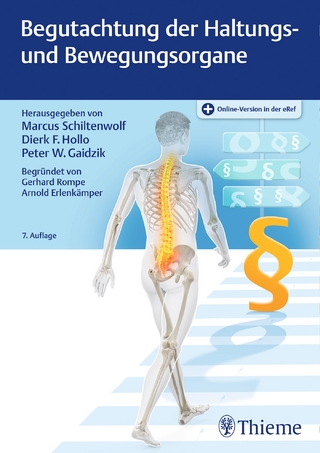
Instructional Course Lectures, Volume 68: Print + Ebook with Multimedia
Wolters Kluwer Health (Verlag)
978-1-9751-2086-3 (ISBN)
- Titel erscheint in neuer Auflage
- Artikel merken
Filled with current, clinically relevant presentations and approaches, Instructional Course Lectures, Volume 68 offers solutions for the most current issues and challenges faced at all stages of your career.
Broaden your treatment options with experience-based solutions from some of today’s most respected surgeons and specialty experts.
Expand and refresh your general orthopaedic, specialty, and practice knowledge
Learn new approaches and surgical techniques from thought leaders
Update your action plans for rehabilitative care with expert insights
From patient care to practice in the digital age, with a particular focus on pediatric orthopaedics, upper extremity and orthopaedic oncology — ICL 68 offers new techniques for solving the tough challenges you encounter in your practice every day.
Chapters are liberally illustrated with radiographs, drawings and intraoperative photographs. Select chapters are enhanced with videos that bring the techniques to life. This new volume provides online access to the current volume and every volume back to and including Volume 51.
Sections include:
Trauma
Upper Extremity
Adult Reconstruction: Hip and Knee
Foot and Ankle
Spine
Pediatrics
Sports Medicine
Orthopaedic Oncology
Orthopaedic Medicine and Practice Management
Enrich Your eBook Reading Experience
Read directly on your preferred device(s), such as computer, tablet, or smartphone.
Easily convert to audiobook, powering your content with natural language text-to-speech.
Section 1 - Trauma
Chapter 1: It’s All About the Timing…When Do I Take This to the Operating Room?
Chapter 2: Current Treatment of Hip Fractures: Can We Reach a Consensus?
Chapter 3: Avoiding and Managing Complications After Hip Fractures Fixation
Section 2 – Upper Extremity
Chapter 4: Clavicle Trauma: From Midshaft Fractures in Contact Athletes to Distal Clavicle Fractures and Acromioclavicular Joint Injuries
Chapter 5: Navigating the Research in Rotator Cuff Disease: An Evidence-based Approach to Improved Patient Outcomes
Chapter 6: Glenoid Bone Loss: Etiology, Evaluation, and Classification
Chapter 7: When You’re Running Out of Room: Managing Humeral and Glenoid Bone Loss in Shoulder Arthroplasty
Chapter 8: Ensuring Accurate Component Placement in Glenoid Bone Loss
Chapter 9: Three- and Four-part Proximal Humerus Fractures: The Gambler Edition
Chapter 10: Elbow Trauma Gone Bad: Instability, stiffness, Non-arthroplasty, and Arthroplasty Options
Chapter 11: Infections of the Upper Extremity: New Developments and Challenges
Chapter 12: Sports Injuries of the Hand, Wrist, and Elbow
Section 3 – Adult Reconstruction: Hip and Knee
Chapter 13: Recurrent Dislocation After Total Hip Arthroplasty: Controversies and Solutions
Chapter 14: Choices, Compromises, and Controversies in Total Knee Arthroplasty
Chapter 15: Four Challenges in Revision Total Knee Arthroplasty: Exposure, Safe and Effective Component Removal, Bone Deficit Management, and Fixation
Section 4 – Foot and Ankle
Chapter 16: Getting it Right the Second Time: Pearls and Principles for Revision Surgery of the Foot and Ankle. Prevention and Treatment of the Failed Flatfoot
Chapter 17: Getting it Right the Second Time: Pearls and Principles for Revision Surgery of the Foot and Ankle. Revision of the Failed Bunion Surgery
Chapter 18: Getting it Right the Second Time: Pearls and Principles for Revision Surgery of the Foot and Ankle. Revision ORIF of Ankle and Syndesmosis Malunions
Chapter 19: Getting it Right the Second Time: Pearls and Principles for Revision Surgery of the Foot and Ankle. Revision of the Failed Ankle Fusion
Section 5 – Spine
Chapter 20: New Paradigms in the Continuum of Spine Care: Newborn to Elderly
Chapter 21: Avoiding and Managing Complications in Routine Lumbar Spine Surgery
Section 6 – Pediatrics
Chapter 22: Developmental Dysplasia of the Hip from Birth to Arthroplasty: Clear Indications and New Controversies
Chapter 23: Pediatric Polytrauma: What is the Role of Damage Control Orthopaedics in the Pediatric Population?
Chapter 24: Fracture Remodeling in Children: Which Fractures Remodel and Which Don’t
Chapter 25: Staying Out of Trouble: Complications of Supracondylar Humerus Fractures
Chapter 26: Lateral Condyle Fractures in Children
Chapter 27: Displaced Radial Neck Fractures: What Are My Options?
Chapter 28: Challenges in Pediatric Trauma: What We All Need to Know About Diaphyseal Forearm Fractures
Chapter 29: Management of Pediatric Forearm Fractures After Failed Closed Reduction
Chapter 30: Monteggia Fractures in Children: History and Current concepts and Management Schemes
Chapter 31: Hand Fractures in Children: How to Avoid Pitfalls and Manage Complications
Chapter 32: Lower Extremity Fractures in Children: How To Avoid Pitfalls and Manage Complications
Chapter 33: Proximal Femur Fractures in Children: Enigmatic Injuries
Chapter 34: Femoral Shaft Fractures in Pediatric Patients: An Algorithm for Success
Chapter 35: Fractures Around the Knee in Children
Chapter 36: Tibia Shaft Fractures in Children: What to do When Casting Fails?
Chapter 37: Pediatric Ankle Fractures: When to Operate and When to Leave Alone
Section 7 – Sports Medicine
Chapter 38: New Paradigms in the Throwing Athlete: Pathophysiology and Examination
Chapter 39: New Paradigms in the Throwing Athlete: Labral Injury, Surgery, and Rehabilitation
Chapter 40: Everything You Need to Know About Knee Ligaments: Case-Based
Section 8 – Orthopaedic Oncology
Chapter 41: Metastatic Cancers to Bone: An Overview and Cancer-Induced Bone Loss
Chapter 42: Pharmacologic and Radiation Therapies for Cancer-Induced Bone Loss
Chapter 43: Epidemiology, Therapeutic Strategies, Outcomes, and Complications of Pathological Fractures
Chapter 44: Reconstruction of the Shoulder and Humerus in Metastatic Bone Disease
Chapter 45: Pathological Vertebral Fractures: Diagnosis, Treatment, Complications, and Controversies Through Case-Based Learning
Chapter 46: Surgical Reconstruction of the Acetabulum and Pelvis in Metastatic Bone Disease
Chapter 47: Femoral and Tibial Reconstruction for Skeletal Metastases and Pathological Fractures
Chapter 48: Bone Tumors and Reconstructive Options in Pediatric and Young Adult Patients
Section 9 – Orthopaedic Medicine and Practice Management
Chapter 49: The Opioid Epidemic: America’s Epidemic
Chapter 50: Pain Relief and the Opioid Crisis in the United States and Canada
Chapter 51: Building Your Practice - Hot Topics
Chapter 52: Designing and Implementing Value-Based Care Delivery and Payment Models for Musculoskeletal Care
Chapter 53: It’s a Brave New World: Alternative Payment Models and Value Creation in Total Joint Replacement
Chapter 54: Patient-Reported Outcomes: How and Why We Collect Them
Chapter 55: The Benefits of National and Regional Arthroplasty Registries
| Erscheint lt. Verlag | 7.3.2019 |
|---|---|
| Reihe/Serie | AAOS - American Academy of Orthopaedic Surgeons |
| Sprache | englisch |
| Maße | 213 x 276 mm |
| Gewicht | 2381 g |
| Themenwelt | Medizinische Fachgebiete ► Chirurgie ► Unfallchirurgie / Orthopädie |
| Medizin / Pharmazie ► Medizinische Fachgebiete ► Orthopädie | |
| ISBN-10 | 1-9751-2086-8 / 1975120868 |
| ISBN-13 | 978-1-9751-2086-3 / 9781975120863 |
| Zustand | Neuware |
| Haben Sie eine Frage zum Produkt? |
aus dem Bereich



